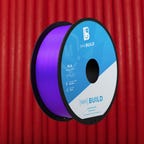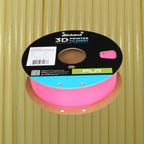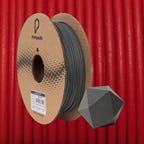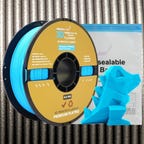Best PLA for 3D Printing
PLA is the most used filament for 3D printing. We've put together the best of the best right here.
Our Picks
When you get your new 3D printer the first thing you will need after getting it all set up is some materials. After all, you can't print plastic models without some plastic. Filament printers, or FDM printers as they're often called, use rolls of extruded plastic to produce the end result and it comes in all shapes and sizes.
The most popular type of filament is PLA, a cornstarch-based material that's versatile and easy to print with. While we have an article about the best 3D printing filament, PLA is so widely used and so varied in its applications that it deserves a standalone article. There are thousands of PLA products to choose from, so we've gathered as many as we can and tested the best ones for you.
What's the best PLA?
If you want to create models you will paint over, then I recommend Matterhackers Build PLA . It's reasonably priced and sands very well, and the more you buy, the cheaper it gets. It's not always the prettiest material, but that doesn't matter if you're going to be painting or otherwise finishing the project and then covering up the plastic.
Best PLA of 2024
Build PLA from MatterHackers is great for projects that require finishing (sanding, painting and so on). I have about 12 rolls of it in my workshop and use it for large projects, including my Mandalorian armor or cosplay swords. The dimensional accuracy -- how consistent the diameter is along the length of the roll -- is good, but it's nothing mind-blowing. It's well within the sweet zone.
Post-processing is where Build Series PLA shines. It's easy to sand and holds paint well if you use a good primer and filler first. Like all PLA, it holds together well using superglue or 3DGloop, and takes putty and Bondo without complaint.
Best glow-in-the-dark PLA
Micro Center Glow PLA
Glow in the dark filament can often be hit and miss as sometimes the glow is weak. This Inland PLA is bright and easy to work with when charged in standard daylight. Just make sure you run it at the highest temperature if you're using a fast 3D printer.
A word of warning though: glow-in-the-dark filament is abrasive and can damage your nozzle if you aren't careful. Try to use a hardened nozzle to keep from ruining them.
Best exotic PLA
Protopasta iron infused filament
There aren't a lot of filaments that blow my mind as much as iron PLA from Protopasta. Because of iron dust infused into the PLA, once it's printed, you can use a solution of vinegar and hydrogen peroxide to make it rusty. It's such a unique way to change the way the standard material looks without painting it. It's a little expensive, but well worth it once you have the exact model you want. Test prints in normal PLA first so you don't waste this pricey material.
Iron infused is another filament best printed with a hardened nozzle as it can be quite abrasive.
Best PLA color
Flashforge Burnt Titanium PLA
Burnt Titanium PLA is the only filament I have on a subscription from Amazon. I get a fresh new roll every month. The mix of purple, blue, black and silver flecks makes layer lines vanish and gives one of the nicest finishes you can get on a 3D print that you haven't sanded and painted yourself.
Best PLA for fast printers
Ataraxia Art high speed PLA
With the advent of fast 3D printers a new type of PLA was needed. High-speed PLA has a lower viscosity than standard PLA and can be printed at higher temperatures with print speeds up to 600mm/s. I was hesitant at first to believe it, but when printing bulk models, or models that are going to be painted or otherwise post-processed this stuff works wonders.
Best Matte PLA
Polymaker PolyTerra Matte PLA
PolyTerra is my go-to budget option when I'm looking for a matte material with beautiful colors. The matte finish makes the PLA look almost pastel and it's stunning when printed. It's also super cheap, so can be used for most applications including sanding and painting.
If you own a Bambu Lab AMS system this might not be the best material though as the cardboard reels can damage the internals.
Best Flexible PLA
Ataraxia Art Flexible PLA
Flexible PLA is a little easier to print with than TPU, the standard for flexible filaments, but has many of the same properties. Ataraxia Art is the best flexible PLA I've used and seems to produce the nicest results. It's perfect for adding flex to your cosplay pieces. I made a helmet for my daughter so she could use it without worry.
Be warned though: It takes a lot of dialing in to get it to print perfectly and you need to keep it dry if you want to avoid stringy prints. If you don't mind spending a little bit of time with it, you can accomplish wonders.
Best bespoke PLA
CookieCad mint chip PLA
Cookiecad makes some of my favorite filaments. The dimensional accuracy is great and the wife-husband team is always inventive with their color choices. The mint chip I've chosen here reminds me so much of the ice cream that it makes me nostalgic for home and walking along the beach with my mum.
There are cheaper filaments out there, but there are few that capture a feeling with the colors quite like Cookiecad does.
How we test PLA filament
Testing focuses on a few details: Dimensional accuracy, winding precision and printing quality. Winding precision is a visual test where I check to make sure the filament works well on the spool, without any crossovers that can cause snags while printing. I measure print quality with a CNET calibration test that I use on all the 3D printers I review. When checking for filament quality, I'm looking for noticeable roughness and missing filament where moisture or other contaminants have interrupted the process of melting and cooling.
Dimensional accuracy is perhaps the most important test as it measures the consistency of filament. As you move along, the filament changes in diameter and will cause the 3D printer to over- or under-extrude filament. This creates noticeable scarring in your model, or worse, complete failure. You want the material to have the same diameter the whole way through.
To measure the accuracy, I take a 5-meter (16.4-foot) piece of filament from the beginning, middle and end of the roll and measure the diameter at four equally spaced points. I then add up all of those measurements and divide the total by 12 -- the total number of measurements taken -- to give me an average across the roll. Most modern printers use 1.75mm filament, so you want the filament to be as close to that as possible.
Great filament has a variance of plus or minus 0.02mm, good filament is plus or minus 0.03mm and rough filament is anything plus or minus 0.05mm. All of the filaments we have recommended here are at least 0.03mm on average.
3D printing PLA FAQ
PLA is the simplest of all filaments to print, but that doesn't mean you won't have questions. I'll answer them as best I can here.






